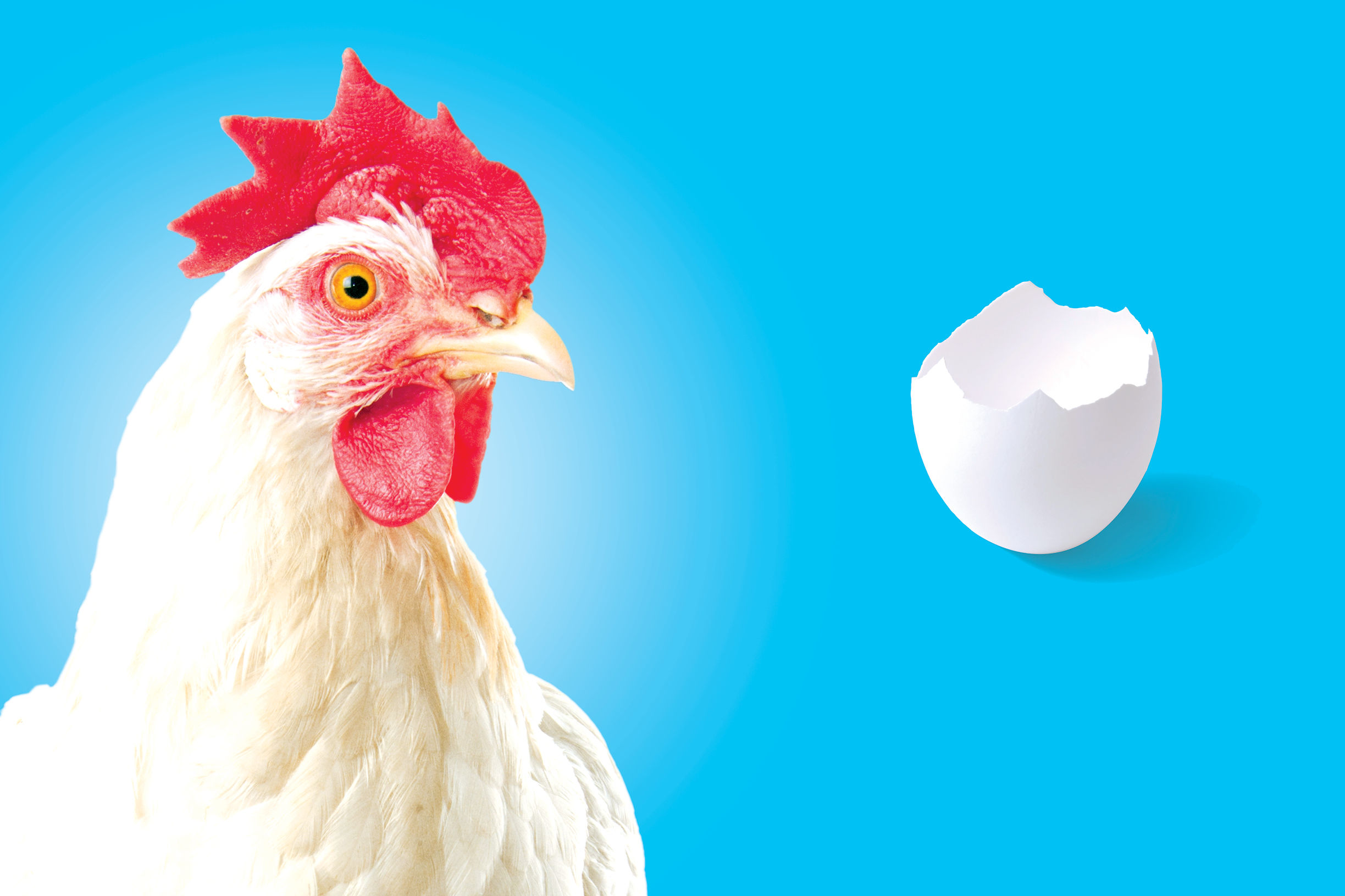
The Truth About ‘Sustainable’ Chicken Is that It Doesn’t Really Exist
Remember Colin?
In a famous early sketch on Portlandia, two diners interrogate a server about the chicken on the menu. Who was he? (He was Colin.) Where did he come from, and how did he live? (Very nearby, free range.) What did he eat? (Sheep’s milk, soy, and hazelnuts.) Finally, one of the diners, still not quite convinced he can devour Colin in good conscience, asks, “Does he have a lot of friends—other chickens as friends?” A parody, the scene nonetheless captured the deep enthusiasm here for seasonal, organic, and ethical eating. It sure is nice to imagine our dinner ingredients living happily, roaming on pasture, and clucking with pals right up until the moment they’re painlessly decapitated.
But in reality, it’s actually quite hard to find Colin and his friends. In Portland, a handful of high-end restaurants—Veritable Quandary and Raven & Rose, to name a couple—do seek out pasture-raised, antibiotic-free chickens from small-scale local farms. But most Portland restaurants—especially those known for chicken—source from agribusiness giants like Foster Farms, Tyson, and Perdue. The brands often used as de facto synonyms for “organic” and “sustainable”—Draper Valley, for instance, and Coleman Natural—are subsidiaries of those big players. High-end grocery chains like New Seasons and Whole Foods tend to stock from similar sources.
In general, whatever the brand name, the chicken industry is not known for humane treatment of animals or concern for the environment. Recently, several of the largest chicken producers announced that they’ll stop using human antibiotics in chicken feed to promote growth, a practice that has been linked to increasing antibiotic resistance in humans. But these companies still routinely cram 20,000 to 40,000 birds into each barn. Here’s New York Times columnist Nicholas Kristof (who grew up on a Yamhill farm) on a typical Perdue barn of 30,000 birds: “These chickens don’t run around or roost as birds normally do. They stagger a few steps ... then collapse onto the excrement of tens of thousands of previous birds.” Chicken manure runoff at these factory-style operations pollutes
waterways, even causing so-called “dead zones” in bodies of water surrounded by chicken operations, such as the
Chesapeake Bay.
These practices, however, have created economies of scale such that even the most enlightened consumers often balk at paying more. Chickens resist the typical locavore narrative of scrappy farmers lovingly raising heritage crops and selling them to mindful eaters. That audience, which has accepted the wisdom of paying more for, say, heirloom tomatoes, will not yet pay more for America’s favorite protein. At Champoeg Farm in St. Paul, Mark Anderson experimented with broilers, the industry term for a chicken raised for meat.
“There’s a glass ceiling on the price per pound of chicken,” says Anderson, who says he would’ve had to charge $6 a pound to have a modest 15 percent profit margin. (A Whole Foods outlet might sell a whole chicken for $15 for a four-pound bird, or around $3.75 per pound.) He ultimately settled on $4–5 a pound, but a good day saw him moving just 20 chickens at the farmers market. Ultimately, he had to discount his birds to $3.99 a pound for a case of eight just to get rid of them.
“Once you go to the hyperlocal stuff, no one is going to pay the plate price,” says Andy Ricker, the Thai food impresario who built his Pok Pok restaurants on a mountain of marinated chicken wings. (His four Portland locations go through two tons of wings every week, sourced from Draper Valley.) “You get a lot of people complaining about how they want free-range, organic, et cetera. But to put that on the plate, that’s going to cost $40.” Today, the Pok Pok flagship sells a half dozen Vietnamese fish-sauce wings for $15.
Yet there is potential demand: a recent study by the Portland environmental nonprofit Ecotrust suggests that restaurants and institutional buyers—schools, hospitals, and the like—in Oregon could buy as many as 5 million pasture-raised, antibiotic-free, local birds annually. That’s 20 million pounds of chicken. But right now—for reasons of size and lack of both infrastructure and capital—Oregon farms can’t produce that amount, or anything like it.
You could say it’s a chicken-and-egg problem.
Chickens are easy—they’re plug and play,” says Reg Keddie, the charismatic fourth-generation farmer who runs Pacific Foods’ organic poultry operations. Keddie, 50, sports a billowing white haz-mat suit and bristly salt-and-pepper stubble as he takes me on a tour of the natural food company’s massive poultry farm in Aurora, 24 miles south of Portland.
I don my own haz-mat suit and we stroll over to a 120-foot-long barn. I dip my bootie-shrouded feet into an iodine solution and brace myself for what’s inside. (Clearly, I’ve read one horrifying Nicholas Kristof column too many.) But instead of the misery and disease documented so often at the massive poultry farms that supply most of the nation’s chicken, I see an apparently healthy flock of white Cornish Cross chickens.

Image: Yevgeniy11
Keddie tells me there are 2,300 of them, just five weeks old. Some hide in the corners of a plywood X—an “indoor enrichment” required by the Global Animal Partnership, an animal welfare rating program also used by Whole Foods and others. Others are playing in the dirt—bathing, Keddie says. When I ask why the barn is so clean, Keddie explains that the chicken droppings are removed every eight weeks and, once composted, used as fertilizer for Pacific’s 2,000-acre farm. In a week, the flock will move inside. Most of these chickens are destined for Pacific Foods’ new “bone broth” line, or for chicken soups and canned chicken products. But some cuts will go to the cafeterias at Oregon Health & Science University and to the high-end meat supplier Nicky USA.
A few years ago, Chuck Eggert, CEO of Tualatin-based Pacific Foods, realized he couldn’t source enough pastured organic chickens from Oregon. So he started raising his own, hiring Keddie to run a spin-off company. Keddie is processing 10,000 chickens a week, plus 2,000 turkeys. The birds are slaughtered at Dayton Natural Meats, one of few USDA-certified processing facilities in the state, which Eggert owns and Keddie also runs.
Even this is not enough chicken for all the broth and soup Pacific sells; the remainder comes from elsewhere. Still, Pacific’s farm hints at what an ecologically sensitive chicken system could look like: big enough to keep prices down, small and conscientious enough to operate responsibly. The trouble is, there just aren’t other similarly scaled operations in Oregon with the same interest in raising chickens “the right way.” A half-dozen such farms or cooperatives could make a difference to the choices broadly available to Portland consumers. Right now, there’s only one.
Amanda Oborne, Ecotrust’s vice president of food and farms, thinks Pacific Foods will be a key player in building Oregon’s “missing middle” of poultry production. Oborne, who recently traveled the state to study Oregon’s regional food system, found that with chicken, the critical gap is this so-called “poultry of the middle.”
“You’ve got these massive poultry producers like Perdue and Foster Farms, or you’ve got little tiny itty-bitty farms,” says Oborne.
Oregon is not a major producer of chicken. Over the years, most farmers here have either become “contract growers” for Big Chicken (companies that are vertically integrated and thus have their own processing plants), or have retired, a version of 1970s federal ag secretary Earl Butz’s legendary mantra: “get big or get out.” The rest have stayed small: most of the 578 chicken farms left produce fewer than 2,000 birds a year. As a result, independent infrastructure—breeders, hatcheries, processing plants—is almost nonexistent. A handful of Oregon farmers are raising antibiotic-free chickens that eat organic feed and spend half their short lives on green pasture. Tyler and Alicia Jones of Afton Field Farm, acolytes of famed Virginia “beyond organic” farmer Joel Salatin, plan to raise 1,000 pastured chickens this year and sell them for $6 a pound to members of their chicken CSA. There’s Deck Family Farm in Junction City ($4.25 a pound), and Kookoolan Farms in Yamhill, where Chrissie and Koorosh Zaerpoor raise 3,700 birds a year ($5.89 a pound for the ones that get organic feed). A small chicken-raising collective is forming outside Eugene.
But these boutique producers do such small numbers, they couldn’t supply a New Seasons–style chain year-round, let alone hospitals, restaurants, and schools. The only Oregon company that seems poised to become a poultry-of-the-middle contender is Pacific Foods, which is already providing OHSU with 400 pounds of chicken a week.
If Pacific Foods can supply breast and thigh meat to OHSU, maybe it can eventually offer drumsticks to Portland Public Schools—or at least that’s what Oborne hopes. “The challenge in any sustainable meat system is to find buyers for all the parts,” says Oborne. At Pacific, Eggert is currently hatching plans to sell broilers via Portland-area Whole Foods. “We hope we can eventually scale up,” he says.
Last year, Piper Davis, co-owner at Grand Central Bakery, couldn’t find an Oregon supplier of organic, antibiotic-free, pastured chicken at an affordable price. “We didn’t think we could charge $13 for chicken salad,” says Davis.
In the face of this predicament, many Portland restaurateurs choose suppliers that have a green hue to their operation but can still produce at scale. Fire on the Mountain, which uses even more wings than Pok Pok at its three Portland locations, sources from Coleman Natural. Pine State Biscuits, which goes through a ton of chicken breast each week for its popular fried chicken biscuits at four locations, uses Harvestland, headquartered in Maryland. Perhaps the most common choice is Draper Valley, a brand comprising roughly 30 Northwest farms that produces 18 million birds a year in three lines: antibiotic-free, organic (which is also “free range”), and “the Ranger” (both antibiotic-free and “free-range”). Since restaurants have slim margins, most choose the antibiotic-free line, which means chickens are raised entirely in barns.
All of these wholesome-sounding suppliers, however, are owned by Perdue, one of the nation’s largest poultry producers—and one that’s often targeted for its environmental and animal welfare practices. And so some sustainability advocates, restaurant owners, and food-industry thinkers remain skeptical of just how good Draper and other major subsidiaries really are. The term “free-range” even has its critics: “It’s just so vague,” says Urvashi Rangan, director of food safety and sustainability at Consumer Reports. “They have the option to go outdoors, but it doesn’t say for how long or whether they actually do it. And it’s not verified.” Portland food purveyors I interviewed also expressed overall quality and freshness concerns about these major greenish brands. (Draper declined to allow me to visit one of its affiliated farms, citing the recent avian flu outbreak.)
At Grand Central, Davis took a radical step: she took her chicken salad off the daily menu at all nine locations. When chicken does appear, as a special or soup, it’s from Mary’s Chicken, a family-owned company based in California’s San Joaquin Valley.
“We use Mary’s first because they’re delicious, second because they are family-owned and in line with our values,” says Davis. “The birds are raised outdoors, not just given the occasional opportunity to look outside.”
Not many Portland restaurants are likely to take the same steps as Davis; chicken, after all, remains exceedingly popular. And that popularity, coupled with Portland’s reigning ethical and environmental values, may eventually solve this conundrum. Ecotrust recently received a $25,000 planning grant from the USDA to help research the chicken supply chain. Ecotrust’s Oborne, who refers to the work on the grant as her “Oregon Chicken Project,” has her eyes on a few key players (in addition to Eggert) who hope to scale up.
Meanwhile, some people are taking matters into their own hands. Geoff Latham of the meat supplier Nicky USA has become so frustrated by the lack of a fresh, truly pastured chicken in Oregon, he’s decided to start raising birds himself.
“It does cost more to raise pasture-raised chicken,” acknowledges Latham, who has plans to use a portable pen to move a flock of 500 chickens to new territory throughout the day on his 36-acre Aurora farm. He also knows there are customers in both Portland and Seattle willing to pay more for a pastured bird. He’s already built a state-of-the art mobile-slaughterhouse and hopes to have USDA approval soon. In the meantime, each week he’s buying pastured chickens from Reg Keddie.
In April, at an Ecotrust panel discussion titled, in fact, “Chicken and Egg,” Burgerville CEO Jeff Harvey announced that 12 years ago, about 64 percent of the proudly regionalist Vancouver, Wash.-based burger chain’s ingredients came from suppliers in the Northwest. “Now we’re at 72 percent, and we can’t get any better in the current system,” he said. “The food system we’re living in and the one we think we’re living in are two different things.” A quick scan of Burgerville’s menu shows that one of the few suppliers from outside the Northwest is for chicken: it gets its birds from Coleman Natural—from Pennsylvania, Delaware, Washington, California, all far from Portlandia.
Hannah Wallace is a Portland-based journalist who writes about food politics, sustainable agriculture, integrative medicine, and travel.




